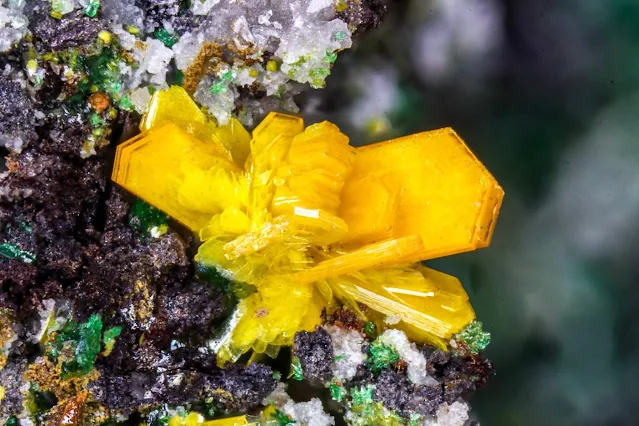Kasolite Crystal
Kasolite is an important hydrated uranyl silicate mineral phase which was found for the first time by Schoep in 1921.
Kasolite is an uncommon mineral that is found as an oxidation product of uraninite and can be found in localities in, additionally, Gabon, Germany, England, France, Australia, the United States, Canada, Mexico, and other minor localities. Kasolite is strongly radioactive.
Its name, was coined by Schoep, emphasizing the locality in which it was found for the first time: the Kasolo mine (Katanga, Democratic Republic of the Congo). Uranyl silicates are the most abundant uranyl minerals in the Earth's surface and form predominantly in uranium rich aqueous solutions containing the ubiquitous silicate ion.
 |
| Kasolite Crystal Flowers. Bright yellow kasolite crystal "flowers" on matrix. Musonoi Mine, Kolwezi, Kolwezi District, Democratic Republic of Congo (Zaïre) Photo: © Stephan Wolfsried |
Kasolite, the only known uranyl silicate containing lead, together with the lead uranyl oxides, such as vandendriesscheite or curite, is among the most relevant lead uranyl containing phases.
The content of radiogenic lead is quite variable but can reach large values in ancient uraninite. Lead may replace uranium to some extent and occupy interstitial sites within the uraninite structure. The accumulation of lead in uraninite induces significant strain in the structure of uraninite and it is eventually released from it. Since lead is relatively immobile in most groundwaters, may form oxides or sulfurs (as galena), but also, under oxidant conditions, may precipitate in the form of uranyl containing minerals. Accumulation of radiogenic lead may also occur in the crystal structure of uranyl containing minerals leading to the destabilization of the structure and yielding the reprecipitation of lead containing secondary phases as kasolite and curite.
Kasolite may also have a non-radiogenic origin, for example from uraninite in contact with other lead containing minerals as galena under oxidant conditions.
 |
| Kasolite Crystal. Musonoi Mine, Kolwezi, Kolwezi District, Democratic Republic of Congo Photo: Henk Smeets/Tomeik Minerals. |
Properties of Kasolite
- Formula: Pb(UO₂)SiO₄·H₂O
- Crystal System: Monoclinic
- Crystal Habit: Radial, Prismatic, Fibrous
- Cleavage: Imperfect on {100}
- Fracture: Conchoidal
- Hardness: 4 - 5 Mohs scale
- Density: 5.83 - 6.5 g/cm³
- Luster: Sub-adamantine, greasy
- Streak: Light brownish yellow
- Diaphaneity: Transparent, translucent, opaque
- Color: Ocher yellow to brownish yellow, amber brown, lemon yellow, to green or reddish orange
- Pleochroism: Weak, pale yellow to orange-brown
- Fluorescence: Weak yellow-green in longwave UV





%20(1).webp)


